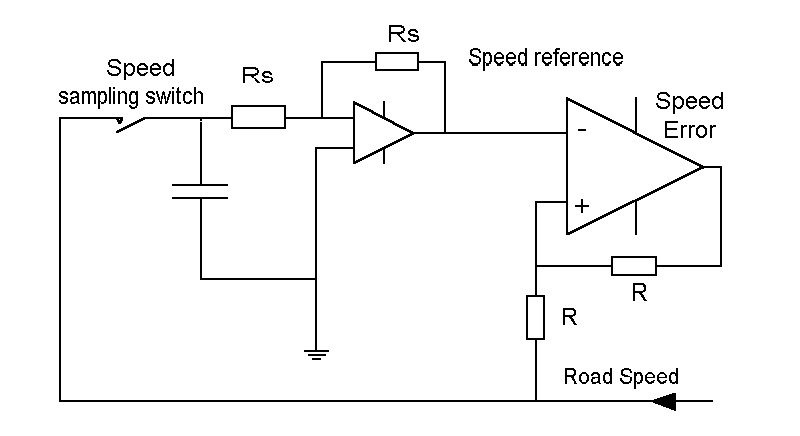by Dr Antony Anderson C.Eng FIEE
3. Cruise Control : Vehicle Speed Control : principles of operation and implementation
The block diagram below shows the main elements of a
typical cruise control system (vehicle speed control
system).With a manual throttle, the cruise control uses a
stand alone speed control amplifier and a servo that
operates on the main throttle. With an electronic
throttle, the cruise control electronics reduces to the
input switches and logic, the electronic control function
becomes part of the Engine Control ECU software and
operates on the main throttle. From a functional point of
view, the cruise control system remains the same with
either a manual or electronic throttle.

A signal proportional to road speed is fed back and compared with a set speed reference to give a speed error signal that is used to control throttle position, and hence engine power, so as to change the speed to reduce the speed error signal to zero. In some analogue systems, the speed reference voltage is held in a sample and hold amplifier that uses a low loss capacitor. [ Note 1]. In other systems, the speed reference voltage is stored as a binary number in a digital counter.
Cruise control systems are well described in "Understanding
Automotive Electronics" Edition 5 by William B.
Ribbens Newnes 1998 ISBN 0-7506-7008-8. Further references
are given in Section 9.
Analog, mixed analog/digital implementations and
fully digital implementations of cruise control systems
are functionally similar, although designs may may look
very different.
The main variations in cruise control system can be dealt
with under three headings relating to: the method of
throttle actuation; the type of electronic control;
the interlocks and safety switches used : -
Method of throttle actuation:
- Electropneumatic servo valve actuation (vacuum, derived from the engine inlet manifold or an electric vacuum pump, is used to provide the force via bellows);
- Electronically controlled DC motor with a worm gear or other reduction gear drive;
- Stepper motor with electronic control. These stepper
motors are often of the very simple switched reluctance
type.
- Analogue + hard wired logic;
- Digital, using a discrete cruise controller;
- Digital cruise control function incorporated in the engine control module.
- Digital cruise control function incorporated in the
Electronic Throttle Control (ECT) and engine ECU, with
electronic systems multiplexed together via typically
one or more CAN-Bus systems. [Note
2]
- Various safety switch interlocks are included to prevent the cruise control system from operating when it would not be safe for it to do so.
- The frequency of the road speed sensor is measured continuously and is compared with a reference in order to provide a logic signal that inhibits the cruise control below a predetermined road speed, typically between 20 and 30 mph. [Note 3]
- Circuitry is designed to disable the cruise control when, for example, slight pressure is applied to the brake pedal.
- In some cases, a measure of protection against cruise actuator malfunction is given either by :
- reducing the supply voltage to the actuator, except when the cruise control is "on" or
- mechanically decoupling the actuator, except when the cruise control is "on", by means of an electromagnetic clutch.
Don't forget to bookmark Section 9 Links and References before leaving this site.
